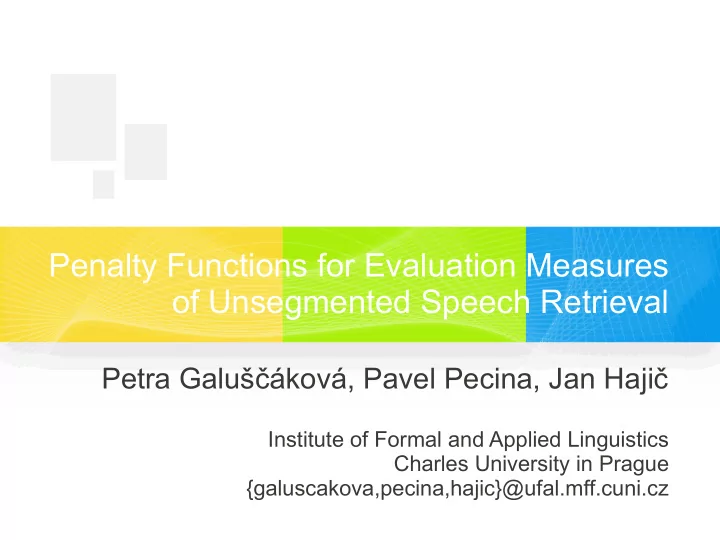

Penalty Functions for Evaluation Measures of Unsegmented Speech Retrieval Petra Galuščáková, Pavel Pecina, Jan Hajič Institute of Formal and Applied Linguistics Charles University in Prague {galuscakova,pecina,hajic}@ufal.mff.cuni.cz
Motivation ● Speech Retrieval ● Retrieving information from a collection of audio data in response to a given query – modality of the query could be arbitrary, either text or speech ● Usually solved as text retrieval on transcriptions of the audio obtained by ASR ● But: speech transcriptions are not 100% accurate, vocabulary is different, speech contains additional elements speech is usually not segmented into topically coherent passages → special evaluation methods for speech retrieval are needed
Evaluation of speech retrieval I ● Known Segments Boundaries ● Speech collection is segmented to passages which can play the role of documents ● Precision/Recall ● Average Precision – arithmetic mean of the values of precision for the set of first most relevant retrieved documents ● Mean Average Precision – arithmetic mean of the AP values for the set of the queries
Evaluation of speech retrieval II ● Unknown Boudaries ● No topical segmentation, the system is expected to retrieve exact starting points for each query ● Mean Average Segment Precision – recently introduced, used in MediaEval – designed for evaluation of retrieval of relevant document parts ● Mean Generalized Average Precision – designed to allow certain tolerance in matching search results against a gold standard relevance assessment – tolerance is determined by the Penalty Function
Evaluation of speech retrieval - mGAP score ∑ p k R k ≠ 0 GAP = N N = number of assessed starting points R k = reward calculated according to the Penalty Function p k is the value of Precision for the position k calculated as: k ∑ R i i = 1 p k = k mGAP = arithmetic mean of the GAP values for the set of the queries
Evaluation of speech retrieval - mGAP score ● Time difference between the starting point of the topic determined by the system and the true starting point of this topic obtained during relevance assessment ● The actual shape of the function can be chosen arbitrarily ● The Penalty Function used in the mGAP measure in the Cross- Language Speech Retrieval Track of CLEF 2006 and 2007
Evaluation of speech retrieval - mGAP score ● Has been widely used, however, the measure (and the Penalty Function itself) have not been adequately studied ● Questions: ● the Penalty Function is symmetrical and starting points retrieved by a system in the same distance before and after a true starting point are treated as equally good (or bad) – “ shape ” of the function itself ● “ width ” of the Penalty Function, i.e. the maximum distance for which the reward is non-zero
Penalty Function Proposal
Methodology ● Lab test to study the behaviour of users ● IR system simulation ● Users were presented the topics from the test collection and playback points randomly generated in a vicinity of a starting point of a relevant segment ● Users should have navigated in the recording and indicate when the speaker started to talk about the given topic ● After they found the relevant segment, the participants were asked to indicate their satisfaction with the playback point Number of participants 24 Number of processed starting points 263
Data ● Test collection used for Cross-Language Speech-Retrieval track of CLEF 2007 ● Manually processed by human assessors – relevant passages for given topics were identified ● Part of oral history archive from the Malach Project (Holocaust testimonies) ● Recorded in Czech Recordings in Malach Project 52 000 Czech recordigs in Malach Project 700 Assessed Czech recordings 357 Average length of the recording 95 min Processed topics 116
Results
Time analysis ● We measure the elapsed time between the beginning of playback and the moment when the participant presses the button indicating that the relevant passage was found ● Respondents generally need less time to complete the task when the playback point is located before the true starting point
Users’ satisfaction ● Participants were requested to indicate to what extent they were happy with the location of the playback points in the scale of: very good, good, bad or very bad ● Trend not clear - most satisfied when the playback reference point lies shortly before the true starting point but function value decreases more slowly for positive time
Proposed mGAP Modifications 1) Users prefer playback points appearing before the beginning of a true relevant passages to those appearing after, i.e. more reward should be given to playback points appearing before the true starting point of a relevant segment 2) Users are tolerant to playback points appearing within a 1- minute distance from the true starting points . i.e. equal (maximum) reward should be given to all playback points which are closer than one minute to the true starting point. 3) Users are still satisfied when playback points appear in two- or three- minute distance from the true starting point. i.e. function should be “wider”.
Proposed mGAP Modifications
Comparison with the Original Measure ● Outputs of CLEF 2007 Cross-Language Speech Retrieval Track ● 15 retrieval system scored with the original and proposed Penalty functions ● High correlation
Conclusion
Conclusion ● We described evaluation of speech retrieval (segmented/not segmented) ● Described mGAP, penalty function drawbacks ● We organized human-based lab test ● Based on lab test results we modified Penalty Function ● Finally compared modified Penalty Function with the original function
Thank you
Recommend
More recommend